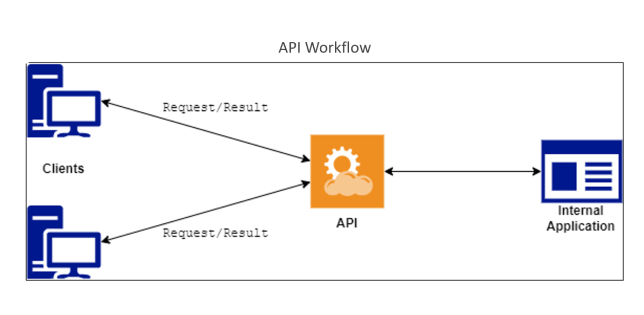API vs SDK: Understanding the Key Differences
In modern software development, Application Programming Interfaces (APIs) and Software Development Kits (SDKs) are pillars shaping how applications communicate and collaborate. As we navigate the landscape of real-time communications, the demand for seamless interoperability has never been more crucial.
Developers must integrate the transformative role of APIs and SDKs in the evolving digital ecosystem to create efficient and interconnected applications.
This article explains the essence of APIs and SDKs, exploring their pivotal roles in fostering collaboration and integration.
Table of Contents
- What is an API?
- Types of API
- Availability and architecture of API
- How does API work?
- Benefits of API
- Use cases of API
- What is SDK?
- Types of SDK
- Resources
- Benefits of SDK
- Use cases of SDK
- Difference between SDK and API
- When to use SDKs vs. APIs
- Embrace seamless video calling with Digital Samba's API and SDK!
What is an API?
The term "API" is a linchpin, facilitating seamless communication and interaction between diverse software components. An API, or Application Programming Interface, acts as a bridge, allowing different applications to exchange data and functionalities efficiently.
Moreover, APIs offer rules that guide the interaction between software components, from simple websites to sophisticated enterprise systems.
Types of API
The types of APIs are as follows:
Web API
SOAP API
REST API
GraphQL API
JSON-RPC
Availability and architecture of API
- Public API: Public APIs are open for external developers and applications, fostering innovation and collaboration in the broader developer community.
- Private API: Private APIs are intended for internal use within an organisation, providing controlled access to specific functionalities.
- Partner API: Partner APIs extend access to select external entities, allowing for strategic collaboration between organisations.
Microservices API
Microservices APIs are designed to support microservices architecture, where applications consist of loosely coupled, independently deployable services.
Monolithic API
Monolithic APIs represent a traditional, all-in-one approach, where an entire application is built as a single unit, potentially leading to more tightly integrated but less scalable systems.
How does API work?
Application Programming Interfaces (APIs) revolve around a fundamental concept: the request-response mechanism. When a client requests, typically through HTTP or other communication protocols, the API processes the request and responds with the requested information or performs a specified action.
In API interactions, a client initiates communication by sending a request to the API, specifying the desired action or information. The interaction is over when the API responds to this request.
Source: BMC
Further, standard architectural styles, such as REST (Representational State Transfer), define the structure and rules for these interactions. RESTful APIs, in particular, use traditional HTTP methods (GET, POST, PUT, DELETE) for requests, providing a uniform and scalable approach to communication.
Benefits of API
Embracing Application Programming Interfaces (APIs) brings many advantages that redefine real-time communication.
Increased efficiency and reliability
Enhanced interoperability and scalability
Facilitation of third-party integrations
Reduced costs
In essence, the benefits of APIs extend beyond mere technical efficiency, playing a pivotal role in shaping cost-effective, interoperable, and highly adaptable software ecosystems.
Use cases of API
The versatility of APIs extends across various domains, revolutionising how applications interact and collaborate. The versatility of APIs, often managed and utilised through an API library, extends across various domains, revolutionising how applications interact and collaborate.
IoT (Internet of Things)
Mapping and geolocation
Web development
Cloud computing
Payment gateway integration
What is SDK?
A Software Development Kit (SDK) is a set of software tools that provides developers with the necessary resources to build, test, and deploy applications for a specific platform, framework, or software ecosystem.
Unlike standalone APIs, SDKs go beyond mere interfaces. They encompass many components, including code libraries, compilers, debuggers, documentation, and sample code. This holistic approach empowers developers by offering a standardised interface and a suite of tools to enhance the development experience.
Types of SDK
The three main types of SDK are:
Native SDKs
Specialised SDKs
Cross-platform SDKs
Resources
- Code libraries: Pre-written code snippets and functions that developers can leverage to expedite development, ensuring standardised and optimised coding practices.
- Compiler: Enables translating high-level programming languages by converting human-readable source code into computer-executable machine code.
- Debuggers: Tools that assist developers in identifying and rectifying errors within their code during the development process.
- Documentation: Comprehensive guides, manuals, and references that elucidate the functionalities and usage of the SDK, aiding developers in understanding and implementing features effectively.
- Tools and utilities: Various tools and utilities, ranging from integrated development environments (IDEs) to performance analysis tools, ensure a smooth and efficient development workflow.
In essence, an SDK is more than a mere toolkit; it is a multifaceted resource that empowers developers to navigate the complexities of software development, fostering innovation and efficiency across diverse application domains.
How does SDK work?
SDKs function as comprehensive toolsets, streamlining the application development process. SDKs comprise essential components, including libraries and APIs, that empower developers with pre-built functionalities and resources.
SDK Components:
- Libraries: These contain reusable code snippets, functions, and modules, eliminating the need to start coding from scratch and promoting code consistency.
- APIs: Offer standardised interfaces, facilitating communication between software components, platforms, or services.
SDKs simplify development by providing developers with tools, documentation, and sample code. This accelerates the development cycle and ensures best practices and optimal utilisation of resources.
For instance, the Video conferencing SDK & API by Digital Samba Embedded is indispensable when exploring communication technology. They enable developers to seamlessly integrate video conferencing functionalities into their applications for efficient and immersive digital communication experiences.
The SDK acts as a bridge, connecting applications and facilitating real-time communication within the digital landscape.
Benefits of SDK
Adopting SDKs brings many advantages that resonate across the entire development lifecycle.
Acceleration of development processes
Enhanced user experience
Cost-effectiveness
By minimising development time and resources, SDKs contribute to cost-effective software development. The pre-built nature of SDK components reduces the need for extensive custom coding optimising budget allocation.
Frictionless integration
Use cases of SDK
SDKs find diverse applications across various domains, showcasing their adaptability and effectiveness in addressing specific development needs.
Mobile app development for iOS or Android
Game development using specific gaming platforms
IoT (Internet of Things) device development
Enterprise software development
In enterprise settings, SDKs prove invaluable for developing software tailored to specific business needs. They expedite development processes and ensure the integration of advanced features within enterprise applications.
These use cases underscore the versatility of SDKs, illustrating how they empower developers in crafting solutions across mobile, gaming, IoT, and enterprise landscapes.
Difference between SDK and API
To comprehend the nuances between Software Development Kits (SDKs) and Application Programming Interfaces (APIs), a tabular breakdown shows key distinctions:
|
Features |
API |
SDK |
|
Definition |
A collection of guidelines and tools for building software applications. |
A toolkit with libraries, tools, and more for software development. |
|
Components |
Primarily, interfaces and protocols for interaction. |
Encompasses libraries, APIs, tools, documentation, and sample code. |
|
Functionality |
Provides a standardised interface for communication. |
Offers extensive tools for the entire development process. |
|
Development Focus |
Primarily concerned with defining communication interfaces. |
Assists developers in creating applications from start to finish. |
|
Scope |
Narrower focuses on determining how software components interact. |
Broader range, covering a variety of tools and resources. |
APIs: Enabling Communication
APIs serve as bridges between different software components, allowing them to communicate, exchange data, and execute specific functionalities. In parallel, custom IoT consulting plays a crucial role in bridging the gap between traditional operations and modern, interconnected systems. They define the rules and protocols for interaction, establishing a standardised interface that ensures interoperability.
SDKs: Extensive Development Tools
On the other hand, SDKs extend beyond interfaces, providing developers with a comprehensive suite of tools and resources. While APIs enable communication, SDKs empower developers by providing libraries, sample code, documentation, and resources that expedite development.
When to use SDKs vs. APIs
The choice between Software Development Kits (SDKs) and Application Programming Interfaces (APIs) hinges on the specific requirements of a project.
Using SDK:
1. Comprehensive Toolset Needed
Opt for SDKs when a comprehensive toolset, including libraries, tools, and documentation, is essential for the development process.
2. Faster Development
SDKs expedite development by offering pre-built functionalities, making them ideal for projects when a quick time-to-market is crucial.
3. Complex Integrations
When dealing with complex integrations that demand various tools, SDKs provide a more holistic solution.
4. Platform-Specific Development
Choose SDKs for platform-specific development, ensuring optimised performance and tailored features for a particular environment.
5. Web/Cloud RTC
In scenarios requiring real-time communication in web/cloud applications, SDKs, such as those for Real-Time Communication (RTC), are often the preferred choice.
Using API:
1. Light Integration Needs
APIs are apt for projects with lighter integration needs, where a standardised interface is sufficient for communication.
2. Customisation Requirements
Opt for APIs when customisation is a priority, allowing developers the flexibility to tailor interactions according to specific project requirements.
3. Platform Independence
APIs excel in scenarios demanding platform independence, enabling communication between diverse systems.
4. Web-Based Services
For web-based services that require interoperability, APIs provide a streamlined communication interface.
5. Web/Cloud RTC
APIs are well-suited for cloud/web Real-Time Communication scenarios, offering a standardised means of communication.
Developers are encouraged to leverage both based on the project's unique needs. While SDKs offer a comprehensive toolkit for development, APIs provide standardised interfaces for seamless communication.
Embracing the strengths of both enhances the efficiency, flexibility, and overall success of software projects.
Embrace seamless video calling with Digital Samba's API and SDK!
Transform your applications into collaborative hubs with Digital Samba Embedded. Elevate user experiences by integrating real-time communication capabilities effortlessly.
Whether you're building web applications, cloud services, or enterprise solutions, our API and SDK provide the tools you need for seamless video conferencing. Unlock the potential of virtual collaboration with Digital Samba—where innovation meets communication excellence.
Explore our video conferencing API and SDK today and revolutionise how your applications connect and communicate.
Share this
You May Also Like
These Related Stories

What are Communication APIs?

What is the difference between TCP and UDP Protocols?




